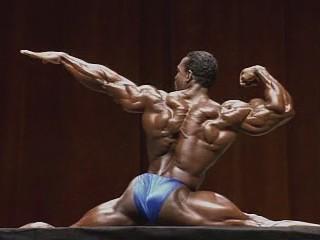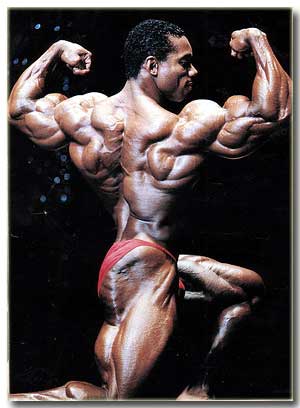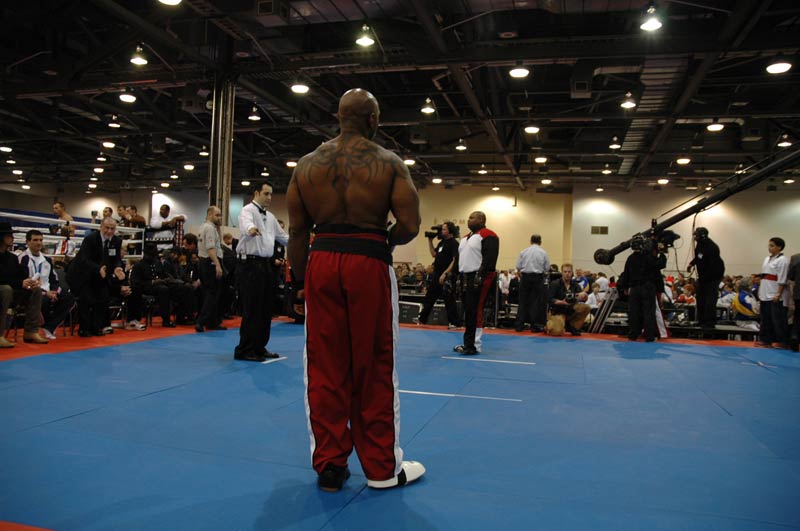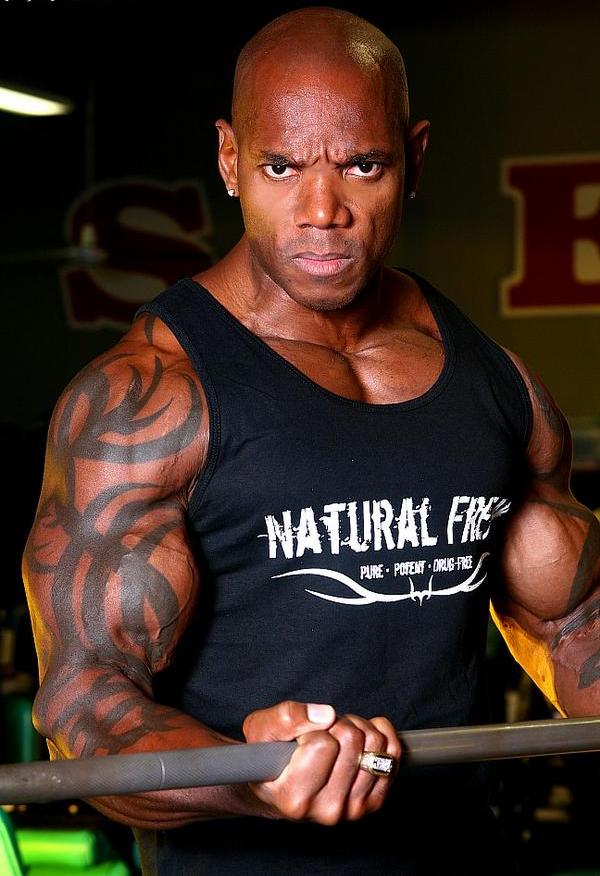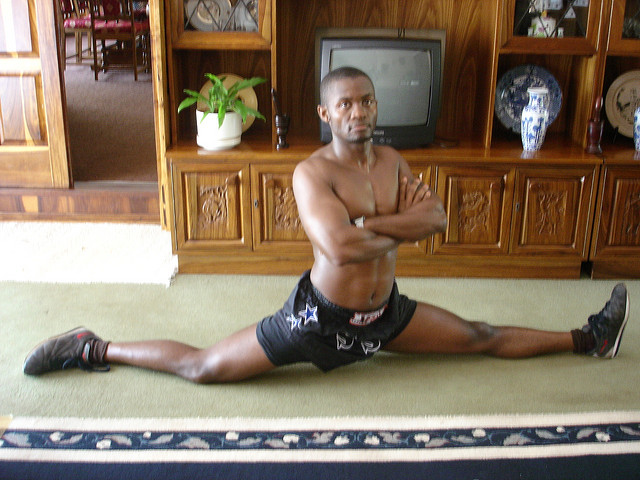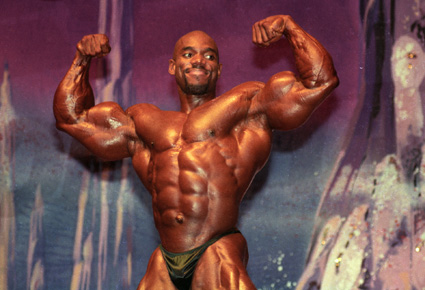Combining Martial Arts with Bodybuilding:
By Idai Makaya
[This article originally appeared in Martial Arts Illustrated Magazine – June 2009].
Over the last few months I’ve had the privilege of speaking to a number of leading personalities in the fields of sports and physical conditioning and have been able to gain some really useful insights into their experiences and beliefs around conditioning – especially in relation to the martial arts. This month I’ll be looking at the aspect of combining martial arts training with bodybuilding – the purposeful bulking up of the muscles to create a larger, more powerful looking physique. This combination of disciplines is quite commonplace in our sport for a number of different reasons – some of which I’ll outline in this article.
To complete the article I will also have details of an interview I held recently with Flex Wheeler, one of the most successful bodybuilders of all time (and also a long time martial artist). My chat with Flex will outline how he has been able to combine the two disciplines successfully over the years and will also outline some of the pitfalls he’s come across in his long training journey.
Bodybuilding is different from generalised weight training in that it’s aimed primarily at enhancing the athlete’s appearance (by growing the muscles), rather than at meeting specified performance measures. It is an aesthetic discipline based mainly on the opinion of the beholder. In combination with martial arts it is best that bodybuilding exercises are also designed to improve your actual physical performance. Luckily, the main foundation of building the muscles is that the stronger a muscle becomes, the larger it has to grow. This is true to varying levels, depending on how one trains, but shows diminishing returns as one increases the level of bodybuilding training. This is actually good news in many ways, because it is probably possible to obtain over 80 percent of one’s maximum bodybuilding potential from very basic training.
Using basic training will suit most recreational bodybuilders and will allow them to divide their time adequately and appropriately towards both disciplines, in order to get the most out of their training.
Even a very basic strength-conditioning program for martial arts can serve as a bodybuilding training program as well – so you can actually drive both sports at the same time.
The key thing to focus on if you do this is to ensure you aim to continuously increase the amount of weight lifted in training, as time progresses, and to use basic compound exercises (which require many muscles to complete the movements). Such increases in the intensity of weight training should be incorporated slowly/gradually to give time for the muscles to adapt to the workload.
The best compound exercises for a strength-building program – which will also build the muscles very well – are squats, deadlifts, bench presses, shoulder presses, rowing movements (with weights) and use of the pull-up bar. A biceps curling movement, some abdominal training and a calf raise movement can be added for complete, full-body training and aesthetic purposes. Don’t perform more than 3 sets of each exercise and you can either do all the exercises in one session – or spread them out across the week (depending on time commitments). The results are usually the same, whichever method you use to group the exercises together.
If you do martial arts and bodybuilding on the same day, always do the martial arts training first.
Once you start to lift heavier weights, you will need to reduce the frequency of bodybuilding training to give the muscles time to repair and develop. Advanced bodybuilders usually only perform the individual exercises just once a week.
The advantages of bodybuilding to a martial artist are:
- Increased strength in all your movements and better knockout capability for self-defense fighting.
- Stronger muscles and joints, which should resist injury better.
- It is easier to develop flexibility in the legs and hips if the muscles are very strong and are trained through a full range of motion (as encouraged in bodybuilding).
- Increased weight – which translates to increased power (this can be a drawback for some athletes who compete in weight-restricted categories, but is usually an advantage for self-defense purposes – where weight differences between fighters are obviously unregulated).
- Training the legs with heavy weights, using one’s full range of motion as prescribed in bodybuilding, is good for flexibility development.
- A more imposing appearance may put off some potential attackers.
The main drawbacks of bodybuilding training for a martial artist are as follows:
- Increased weight can affect stamina negatively, as a heavily fatigued fighter loses much of his/her added knockout power in a long, fast-paced bout and the additional muscle mass developed through bodybuilding then becomes excess weight instead.
- Training too heavily in bodybuilding can affect your martial arts training because your muscles may not have recovered sufficiently from the weight training sessions so the quality of your martial arts training and performance will be adversely affected.
- The high levels of cardiovascular training required for good martial arts performance will often impair the capacity for your muscles to grow as a bodybuilder.
- The calorie-restricted dieting required to bring out good muscle definition in bodybuilding will often counteract the athlete’s ability to complete long, tough training sessions – which makes the combination of the 2 different sports even more difficult.
Now for the interview I held with Flex wheeler, one of the most revered athletes in the bodybuilding world with one of the most revered physiques in bodybuilding. A brief background on Flex would read as follows:
- Born in Fresno, California in 1965.
- Started martial arts training aged 9 (is said to have won numerous fights in Karate, before going professional as a bodybuilder in his mid 20s).
- Started bodybuilding aged in his early teens and has won more major shows than any other bodybuilder – although he never captured the revered Mr Olympia title (was second on a few occasions).
- Initially used an ‘alternate day’ training combination – with martial arts and bodybuilding sessions always done on separate days – training in each discipline for an equal number of days each week.
- Broke his neck in a serious car accident in the early 90s but made a bodybuilding comeback – going on to win some of bodybuilding’s most prestigious contests and truly establishing himself in the sport.
- Had a series of surgical operations from around the year 2000, leading up to a kidney transplant in 2003 and shoulder surgery in 2005.
- After the transplant he has appeared in an exhibition kickboxing bout at the Arnold Schwarzenegger Classic, which he won. He also stopped using bodybuilding drugs and rebuilt his massive physique after his illness.
- Flex now trains in both bodybuilding and martial arts – at an amateur level only.
- He is currently PR Director of AAEFX Nutrition, a company making nutritional supplements for bodybuilding and mixed martial arts training.
- Flex features in a new international documentary called “How Bruce Lee Changed the World.” He is featured alongside John Woo, Jackie Chan, LL Cool J, Jet Li, Michelle Yeoh, Brett Ratner, Eddie Griffin, RZA from the Wu Tang Clan, Guy Ritchie, Stan Lee, The Gorillaz, Michael Bay, Ang Lee, UFC’s Randy Couture, UFC President Dana White and Parkour founder Sebastian Foucan.
Below is a summary of an interview for MAI, in which Flex was very friendly, animated and informative:
Idai Makaya: Hi Flex, how is your training going at the moment?
Flex Wheeler: It’s going great. I am currently in the process of peaking for a photo shoot to promote a new line of sports supplements which AAEFX is releasing.
Idai Makaya: What martial arts styles do you train in at the moment and why?
Flex Wheeler: I normally train in the style of the local instructors in any area that I live in. I believe martial arts training is more about the fighter than the particular style studied. A good fighter is a good fighter – regardless of his/her martial arts style. I currently do Olympic Taekwondo and was really getting into it recently, despite the fact that I am in my mid forties now!
Idai Makaya: What has curbed your enthusiasm for martial arts training?
Flex Wheeler: I still train hard but I injured myself a few times recently and that forced me to take stock of things and consider my age. I got a serious knee injury when trying to make the Taekwondo team – I often get carried away with my competitive approach to sports! I guess it comes from being in professional sports for so long.
(IM: Always take age into account when considering recovery ability from training)
Idai Makaya: Are you still as flexible as you were in your competitive bodybuilding days, when you could do all the versions of the splits, etc?
Flex Wheeler: These days it comes and goes, depending on what I’m doing. I was overdoing the flexibility training due to my renewed enthusiasm for making the Olympic
Taekwondo team, while also training full-on in bodybuilding for our new product launch. I guess something had to give and I seriously hurt my knee – so I’m not that great at the moment. But I’ll hopefully get better! I just thought, Olympic Taekwondo is so much simpler and less complex than some other martial arts codes – and I’m good with my kicks – so I figured even more flexibility would help me.
But I’m 43 now and the heavy schedule meant I tore my knee by accident. Before the Arnold Schwarzenegger Classic exhibition bout in 2005 I also tore my rotator cuff and almost pulled out – that’s why I was getting a little gassed out during the last parts of the fight. It was a disappointment from that perspective.
(IM: Training hard for 2 sports can take it’s toll).
Idai Makaya: Sorry about that Flex, at least you won the fight. Is the knee injury impacting on your bodybuilding at all? What shape are you in at the moment?
Flex Wheeler: I’m actually going along well with my bodybuilding training, despite it all. I weigh between 215lbs and 225lbs – not bad for my age, etc. I’ve taken a full 8 months to get in shape using my new supplement lines. The martial arts training is really good for my stamina. As a pro bodybuilder I had to drop my martial arts training for a few years – you can’t do both at that sort of level and still do yourself justice. For that reason I was really
out of shape when I started martial arts again after a 10 year break. I also noticed my reflexes weren’t like they used to be, I was de-trained. Like I said, I was disappointed by my performance at the Arnold Schwarzenegger Classic because my shoulder injury lost me a lot of training in the lead-up to the fight. I got tired really quickly. Pure bodybuilding training does nothing for your endurance, unfortunately – it was a little embarrassing as a pro athlete. But I’m up to speed now.
(IM: Bodybuilding gives strength but does little for stamina).
Idai Makaya: To end off, what does the future hold for Flex Wheeler? I know you were recently invited to take part in the latest Bruce Lee Documentary. Please tell me more.
Flex Wheeler: It looks like the supplement business is the main thing I’ll be doing now – but I’ll also keep my martial arts and bodybuilding training going. I’m currently PR Director
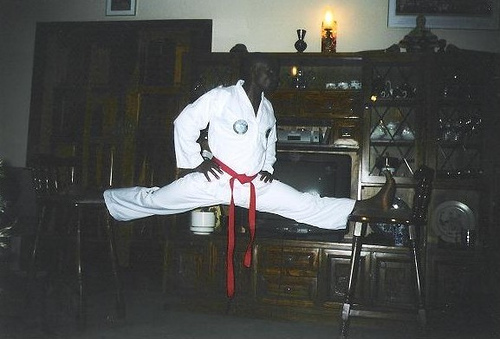
Idai Makaya believes Suspended Splits can’t be done without the strength gained from Bodybuilding Training – and proves it in this image.
for AAEFX Supplements and we are shortly releasing the Flex Wheeler Signature Line of nutritional supplements – good clean supplements for bodybuilders and mixed martial artists. I like helping other athletes and we sponsor a few mixed martial artists at the moment.
I also still write my monthly column for Muscular Development Magazine and recently completed filming for a new documentary supported by the Bruce Lee Foundation, about the life of Bruce Lee and all the athletes he has inspired. It’s called “How Bruce Lee Changed the World“ and is set to air on the History Channel (and internationally) to mark
the 35th anniversary of Bruce Lee’s passing. Bruce’s daughter, Shannon, is an executive producer on this documentary and his widow Linda has also cooperated with the production company, Waddell Media, to make this prime time documentary a reality.
Idai Makaya: Thanks Flex, it’s been a pleasure speaking to you and it’s great to see you getting more involved in the martial arts again. Good luck for the future and God bless you.
In conclusion, I hope this short interview will give martial artists some insights into combined martial arts and bodybuilding training and perhaps some of Flex’s experiences will help you with your own workload planning and decision processes – if you are considering taking up bodybuilding in any shape or form.
Always remember, when it comes to training, as in life in general – if you fail to plan you plan to fail. Knowledge is power so please make sure you find out as much as possible
about any aspect of conditioning you want to take up – BEFORE you actually make changes – so your decisions are then based on good information. Balance training and look out for injury. That way you will always succeed.
My future articles will continue to look at the various conditioning and training options that confront us as martial artists and will hopefully cast more light on how you can use new ideas to keep yourself challenged and continuously getting better. Happy training until then!


